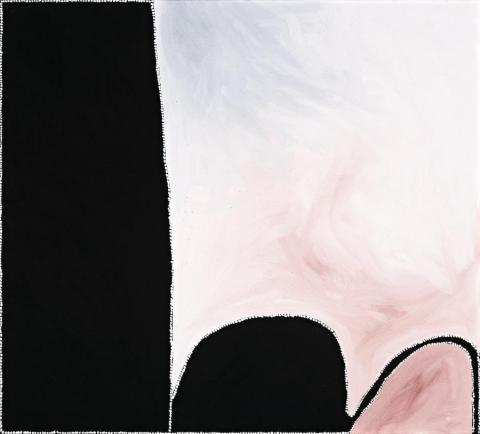WIRWIRJI - POLICE HOLE, 2004
PADDY NYUNKUNY BEDFORD
natural earth pigments with synthetic binder on linen
122.0 x 135.0 cm
initialled verso: PB
inscribed verso: title and Jirrawun Aboriginal Arts cat. PB 6 2004.176
Jirrawun Aboriginal Arts Corporation, Kununurra
Private collection, Adelaide
Storer, R., Paddy Bedford, Museum of Contemporary Art, Sydney, 2006, p. 154 (illus.)
Sir William Dean in his eulogy to Paddy Bedford, in September 2007, recalled that Bedford was a man of 'great dignity and spiritual strength ... a much loved senior Elder and lawman who late in the story of his life discovered a rare artistic genius that resulted in him being recognised as one of the great painters of our continent.'1
Nyunkuny, commonly known by his nickname 'Kuwumji' and also by his 'gardiya' name Paddy Bedford, was a Gija lawman of Jawalyi skin. Born at Bedford Downs Station in the East Kimberley in 1922, Bedford recalls stories of his family hiding from the massacres that still occurred in the pastoral leases of the Kimberleys. In 1920, just two years before Paddy's birth, several Gija men were poisoned, beaten to death and incinerated on a pyre made from trees they'd just cut down. Murdered for killing a dairy cow, that had been grazing on lands once physically and spiritually their own. Paddy Bedford was named by and after the infamous Paddy Quilty, who organised the massacre, and Bedford came from Bedford Downs, the station on which it happened and where as a young man, he worked as a stockman. When Aboriginal pastoral workers were finally awarded equal wages in 1969, Indigenous stockmen were unceremoniously expelled from cattle stations across the Kimberleys. As reported in The Australian (Friday 20 July 2007) Bedford, a skilled stockman, was forced to work on construction crews along the Gibb River Road, moving rocks and other manual labour. During this time he lived between Nine Mile camp at Wyndham and Turkey Creek Mission settlement which was to become the home of the first great generation of East Kimberley artists in the early 1980s. According to Tony Oliver (who was to prove instrumental in Bedford's career and the development of Jirrawun Aboriginal Art Corporation) Bedford was close friends with Paddy Jaminji, Hector Jandany and Rover Thomas, whose canvases he helped to prepare and whose progress he quietly observed. But it was only after these pioneers of the Kimberley movement died that Bedford took on the responsibility of painting ceremonial boards.
In 1997 he started painting his stories on board and canvas with a remarkable authority and confidence that reflects his importance as a traditional elder of high regard. The rest is legend. Within several years Bedford acquired a reputation for not only inheriting the legacy of Rover Thomas but of pushing new boundaries with his famously fluent 'walking line'. Steeped in traditional law and the Ngarranggarrni (Gija dreaming) he drew on a seemingly endless source of traditional lore and knowledge of significant sites. His paintings combine important family Dreamings such as Garnanganyjen (Emu), Birnkirrbal (Bush Turkey) and Ngayilanji (White Cockatoo) with the physical world of roads, rivers, traditional life, stock camp life, stock yards and country visited while mustering. His work has been hailed as that of a 'new' Rover Thomas even though he was born a few years before him.
The importance of painting for Paddy Bedford was multi layered; an expression of country and cultural memory as well as being a claim to identity and consequently an assertion of claim to the land itself. As Michael Dolk argues, painting suggests a physical and tactile relation to land 'To behold painting is to hold country and to remain beholden to its ancestral tradition.'2
Catalogued as painting PB 6 2004.176 in Bedford's chronological index of works, this painting on linen was executed in 2004, and represents the country of Wirwirji (Police Hole). Also known as Tea Hole and Donkey Hole, it is located just to the north west of Bedford Downs in his mother's country and is home to a deep permanent waterhole. This is the place where his mother died when she was only middle aged. Her body was wrapped in paperbark and placed in caves in the traditional ways of this country.
Wirwirji characterises Bedford's move away from the more familiar style of the earlier east Kimberley painters to create his own representations of country. His use of colour has evolved with the elimination of an ochre palette and the introduction of a starkly contrasting black and white ground often softened by washes of pink and blue. The power of the form becomes dominant, highlighting the interplay between the positive and negative space.
In 2006, in recognition of his outstanding contribution to Australian, and indeed world, culture he was honoured by a major retrospective of his work at the Sydney Museum of Contemporary Art in 2006. He was also one of the handful of Aboriginal artists commissioned to contribute to the permanent collection of the Musée du quai Branly in Paris. Since his death in 2007 aged 85, his paintings have continued to be keenly sought after as the significance and quality of his astonishing body of work becomes increasingly evident.
1. Dean, Sir William,'Eulogy for Old Man,' in Paddy Bedford; Bury My Heart at Bow River, exhibition catalogue, William Mora Galleries, Melbourne, 2009, p. 14
2. Dolk, M., 'Are We Strangers in this Place?', in Storer, R., Paddy Bedford, Museum of Contemporay Art, Sydney, 2006, p. 20
CRISPIN GUTTERIDGE
